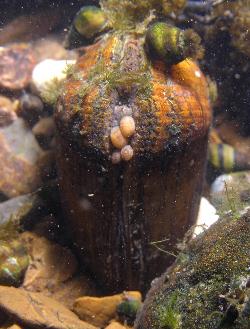
Current Projects
Development of Genetics Management Plans
Captive propagation and reintroduction of freshwater mussels has become a common management tool over the last ten years. Freshwater mussels are now routinely propagated in hatcheries across the United States, including at many National Fish Hatcheries. We are using population genomic analyses to inform the development of propagation plans. Our research is used to inform important hatchery decisions such as choice of appropriate broodstock populations and propagation protocols that ensure appropriate levels of genetic diveristy in captively propagated populations. We work on a variety of freshwater species, ranging from Lake Sturgeon to Brook Floater mussels.
Molecular Ecology and Conservation Genomics of Freshwater Mollusks
We use population genomics data and analytical tools to assess how genetic diversity varies across a landscape so we can make inferences about ecology and evolution of freshwater mollusks. For example, we use genomic data to understand migration patterns and historical population trends. Data we generate are often used for conservation assessments by state and federal agenices. Our population genomics work mostly focuses on the freshwater snail family Pleuroceridae and the freshwater mussel families Margaritiferidae and Unionidae. However, we also do work on fish and amphibians to help USFWS conservation efforts.
Genetic Monitoring of Hatchery Programs
As a USFWS research lab, one of our missions is to perform genetic analyses that aim to evaluate and improve propagation work at National Fish Hatcheries. This work includes using population genetics to identify appropriate broodstock populations and to evaluate hatchery success. For example, we use standard genetic parentage analyses to measure hatchery contribution to the American Shad population in the Edisto River in North Carolina. Another project is genetically determining species identification of frog eggs brought into hatcheries for captive propagation. Species we work on include Lake Sturgeon (Acipenser fulvescens), American Shad (Alosa sapidissima), Striped Bass (Morone saxatilis), and Sicklefin Redhorse (Moxostoma sp.), and Gopher Frog (Rana capito). Hatchery partners include Warm Springs National Fish Hatchery, Bears Bluff National Fish Hatchery, and Welaka National Fish Hatchery.
Black Bass Genetic Management
We work with several states and private entities to monitor the genetic composition of Black Bass. For this, we developed a genotype-by-thousands (GT-seq) SNP panel that can be used to assess species purity and introgression. The primary focus of this work has been to monitor the presence of Florida Bass and Largemouth Bass alleles in managed Black Bass stocks, including confirmation of F1 hybrids. We use these data to confirm species ID and examine the extent of non-native Alabama Bass introgression in native Black Bass species.